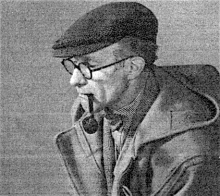
Ernest Wamsley Lewis was born in London, England on 16 February 1898 and moved to Radipole, a suburb of Weymouth, Dorset as a child. After serving in the Army in Italy during World War One, he trained as an architect at the Architectural Association in London from 1921 to c.1925 when he received his AA Diploma. He was elected an Associate of the Royal Institute of British Architects (ARIBA) in 1926 and in 1927 was awarded the RIBA Alfred Bossom Gold Medal and a travelling scholarship to America.
He subsequently practised as an architect in Weymouth, Dorset. His particular interests were theatre and cinema design and architectural restoration.
In the 1930s he spearheaded a campaign to save the 2-3 Trinity Street, a Tudor house in Weymouth which was threatened with demolition. He later purchased the building himself and, with the aid of the Dorset County Museum, completely restored it. In 1977the building was bequeathed to Weymouth Civic Society and is now the Tudor House Museum.
During the late 1940s and early 1950s, he was President of the Wilts and Dorset Society of Architects. In 1946 he founded the Weymouth Civic Society and was its first Honorary Secretary.
His address was given as Kia Ora, Radipole Spa, Weymouth, Dorset in 1928 and 1939; and 70 St. Thomas Street, Weymouth, Dorset in 1950. He died in Weymouth, Dorset on 5 December 1977. His address at the time of his death was 41 Icen Road, Weymouth, Dorset
A biographical file on Ernest Wamsley Lewis is available on request from the Enquiry Desk, Royal Institute of British Architects Library, London.
New Victoria Cinema, London (1928-30); Littlecot, Plaisters Lane, Sutton Poyntz, Dorset (1932); Staddles, Plaisters Lane, Sutton Poyntz, Dorset (1933); Long Acre, Lyme Road, Uplyme, Devon (1933); Greystones, 7, Belfield Park Drive, Weymouth, Dorset (1933); 23, Easton Way, Frinton-on-Sea, Essex (1935-38); Russet Cottage, Plaisters Lane, Sutton Poyntz, Dorset (1936); Spinneys, Plaisters Lane, Sutton Poyntz, Dorset (1936); Valley Cottage, Plaisters Lane, Sutton Poyntz, Dorset (1937); Straitways, 54, Buxton Road, Weymouth, Dorset (1937); Harcourt Elementary School, Folkestone, Kent (1938); Cob Cottage (formerly Watermeadow), White Horse Lane, Sutton Poyntz, Dorset (1939); Whatcombe House, Long Bredy, Dorset (1930s); Four Winds, Broadmayne, Dorset (1930s); West Hope, Angel Lane, Langton Herring, Dorset (1951); 59, Wyke Road, Weymouth, Dorset (1953); Greatfield House, Affpuddle, Dorset (1950s); The Coombe House. 1, White Hill, Puddletown, Dorset (1950s); Egdon Cottage, 9, de Moulham Road, Swanage, Dorset (1950s); Arden Lea House, 1a (formerly Lavenders), Manor Road, Weymouth, Dorset (1950s); Rappele House, Radipole Lane, Weymouth, Dorset (1950s); and Farleton, Fernhill Lane, Balsall Common, near Coventry (1950s).
Ricketts, Eric. ‘E W Lewis (1898-1977)’. RIBA Journal vol. 85, no. 4, April 1978 p. 153.
School at Folkestone (Harcourt Elementary School)’ Architect & Building News 30 June 1939 p. 340
Seaside Houses and Bungalows. Edited by Ella Carter. London: Country Life, 1937